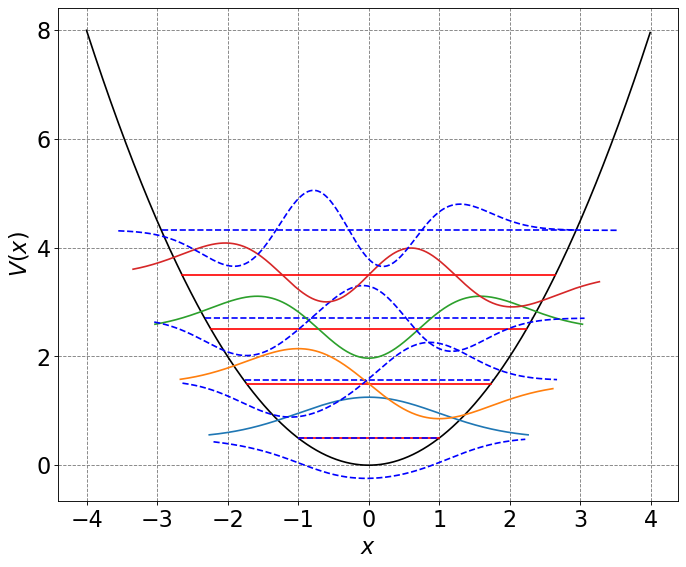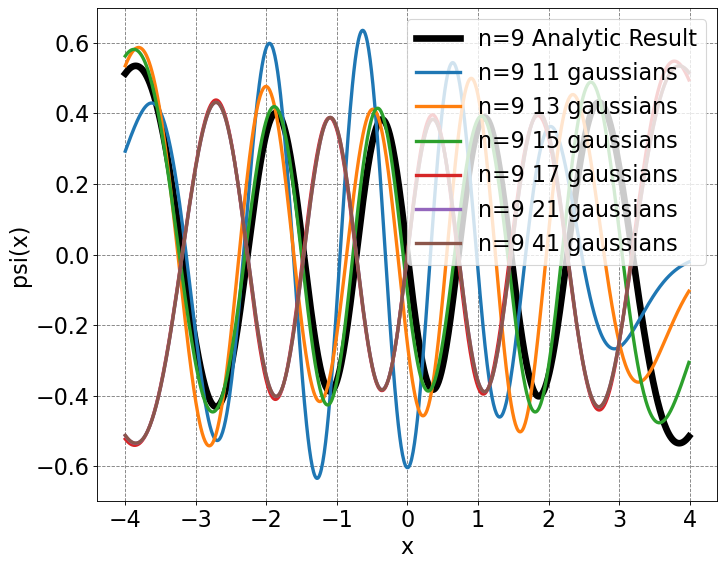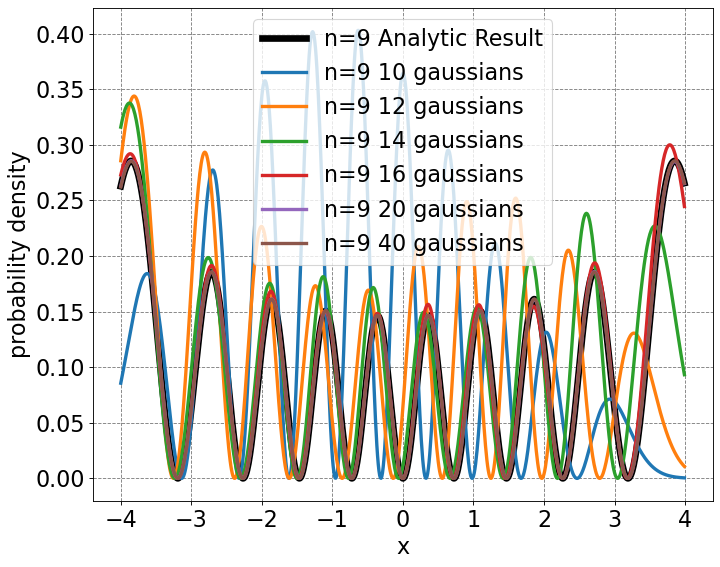4.5.25. Variational Solution to the Harmonic Oscillator#
4.5.25.1. Motivation#
Let’s see how to use the variatianol approach in QM to estimate solution to the quantum harmonic oscillator
4.5.25.2. Learning Goals#
After going through these notes, you should be able to:
Approximate the HO wavefunctions as a sum of Gaussians
Compute the variational matrix elements for the HO given Gaussian basis functions
Use code provided to estimate the variational solution for fixed number of Gaussians
4.5.25.3. Coding Concepts#
The following coding concepts are used in this notebook
4.5.25.4. Determing the Variational Solution to the HO Problem with Gaussian Basis Functions#
Let’s consider a harmonic oscillator with Hamiltonian
\(\hat{H} = -\frac{\hbar^2}{2m}\frac{d^2}{dx^2} + \frac{1}{2}x^2\).
We will solve this problem using the variational solution with gaussian basis functions and compare these results to the analytic solution. We start by approximating the wavefunction, \(\psi(x)\), as an expansion of gaussians
\(\psi(x) \approx \sum_{i=1}^Nc_ie^{-\alpha(x-x_i)^2}\).
where the \(g_i(x) = e^{-\alpha(x-x_i)^2}\) is the \(i\)th gaussian basis function with width \(1/\alpha\) and centered at \(x_i\). We must derive expressions for the following matrix elements
\( H_{ij} = \langle g_i|\hat{H}|g_j\rangle\)
and
\( S_{ij} = \langle g_i|g_j\rangle \).
We will not go through all of the steps here (you are welcome to do so for homework and have to do the third order term for homework). We note, however that since \(\hat{H} = \hat{K} + \hat{V}\) we can write the Hamiltonian matrix element as a sum
\( H_{ij} = \langle g_i|\hat{K}|g_j\rangle + \langle g_i|\hat{V}|g_j\rangle\).
Performing the integrals and simplifying the algebra leads to
\( H_{ij} = \frac{1}{2}\sqrt{\frac{\pi}{2\alpha}}e^{-0.5\alpha(x_i-x_j)^2}\left(\alpha - \alpha^2(xi-xj)^2 + \frac{1}{4}(\frac{1}{\alpha} + (x_i+x_j)^2) \right)\)
and
\( S_{ij} = \sqrt{\frac{\pi}{2\alpha}}e^{-0.5\alpha(x_i-x_j)^2} \).
A brief note on the algebra: the product of two gaussians yields a gaussian. You have to complete the square in the exponent. E.g.
\( e^{-\alpha(x-x_i)^2}e^{-\alpha(x-x_j)^2} = e^{-1/2\alpha(x_i-x_j)^2}e^{-2\alpha\left(x-\frac{x_i+x_j}{2}\right)^2}\)
where the first term on the right-hand side of the above equality is a constant (exponent does not depend on \(x\)) and the second term is a guassian centered at \(\frac{x_i+x_j}{2}\).
The goal now is to diagonlize (/compute eigenvalues and eigenvectors of) the matrix \(\mathbf{S}^{-1}\mathbf{H}\). In order to do so we must choose the number of gaussians, width of gaussians and spacing of gaussians. We will investigate the effect of changing the number of guassians but fix the width to be one (\(\alpha = 1\)) as well as fix the spacing to be 0.4. The subsequent code computes the two matrices, diagonalizes the product and then returns the variataional energies and normalized variational wavefunctions.
4.5.25.5. Code to perform variational solution of HO#
# import standard libraries
import numpy as np
import matplotlib.pyplot as plt
# routine to initialize "pretty" plots
def define_figure(xlabel="X",ylabel="Y"):
# setup plot parameters
fig = plt.figure(figsize=(10,8), dpi= 80, facecolor='w', edgecolor='k')
ax = plt.subplot(111)
ax.grid(b=True, which='major', axis='both', color='#808080', linestyle='--')
ax.set_xlabel(xlabel,size=20)
ax.set_ylabel(ylabel,size=20)
plt.tick_params(axis='both',labelsize=20)
return ax
from scipy import integrate
# variational principle basis set solution to the harmonic oscillator - basis functions are guassians
def basis_ho(N): # N is half the number of basis functions
K = 2*N+1 # total number of basis functions to make it symmetric
dx = 0.4 # spacing between basis functions
alpha = 1.0 # 1/spread of basis functions
xvals = np.arange(-4,4,0.01) # x domain for psi
xmin = -N*dx # minimum x value for basis functions
xIntMin = xmin - 10.0*1.0/alpha
xIntMax = N*dx + 10.0*1.0/alpha
xInt = np.arange(xIntMin,xIntMax,0.01)
S = np.zeros((K,K),dtype=float) # basis function overlap matrix
H = np.zeros((K,K),dtype=float) # Hamiltonian matrix
# populate the basis function, S, and Hamiltonian, H, matrices
for i in range(K):
xi = xmin + (i-1)*dx
for j in range(K):
xj = xmin + (j-1)*dx
# basis function value:
# Ostlund and Szabo page 47
S[i,j] = np.sqrt(0.5*np.pi/alpha)*np.exp(-0.5*alpha*(xi-xj)**2)
# Hamiltonian value (standard Harmonic Oscillator matrix element - applied to basis functions)
H[i,j] = 0.5*S[i,j]*(alpha - (alpha**2)*(xi-xj)**2 + 0.25*(1.0/alpha + (xi+xj)**2) )
#print(H)
#print(S)
# finalize the S^-1*H*S matrix
SinvH = np.dot(np.linalg.inv(S),H)
#print(SinvH)
# compute eigenvalues and eigenvectors
H_eig_val, H_eig_vec = np.linalg.eig(SinvH)
# reorder these so smallest eigenvalue is first
idx = H_eig_val.argsort()
H_eig_val = H_eig_val[idx]
H_eig_vec = H_eig_vec[:,idx]
nx = xvals.size
psi = np.zeros((nx,K),dtype=float)
psiNorm = np.zeros(xInt.size,dtype=float)
# generate psis from coefficients
for A in range(K):
count = K-A-1
psiNorm = 0.0
for i in range(K):
xi = xmin + (i-1)*dx
psi[:,A] = psi[:,A] + H_eig_vec[i,A]*np.exp(-alpha*(xvals-xi)**2)
psiNorm = psiNorm + H_eig_vec[i,A]*np.exp(-alpha*(xInt-xi)**2)
# normalize the wavefunctions
psi2 = np.power(psiNorm,2)
norm = integrate.simps(psi2,xInt)
psi[:,A] /= np.sqrt(norm)
return psi, H_eig_val
# compute psis:
psi5, E5 = basis_ho(2)
#psi10, E10 = basis_ho(10)
# let's plot the energy levels and wave functions
from scipy.special import hermite
from scipy.special import factorial
# start by defining N function for analytic solution to HO wavefunctions
def Nn(n,alpha):
return 1/np.sqrt(2**n*factorial(n))*(alpha/np.pi)**0.25
# initialize a figure
ax = define_figure(xlabel="$x$",ylabel="$V(x)$")
hbar = 1.0
k = 1.0
m = 1.0
omega = np.sqrt(k/m)
alpha = np.sqrt(k*m)/hbar
x = np.arange(-4,4,0.01)
x2 = np.power(x,2)
U = 0.5 * (omega)**2 * x**2
ax.plot(x, U, 'k')
for n in range(4):
# compute and plot energy levels
evals = hbar*omega*(n+0.5)
mask = np.where(evals > U)
ax.plot(x[mask], evals * np.ones(np.shape(x))[mask], 'r-', label="analytic")
# plot variational energy levels
mask = np.where(E5[n] > U)
ax.plot(x[mask], E5[n] * np.ones(np.shape(x))[mask], 'b--',label="variational")
# compute and plot analytic wavefunctions
psi = (-1)**n*Nn(n,alpha)*hermite(n)(np.sqrt(alpha)*x)*np.exp(-alpha*x2/2.0)
Y = psi+evals # shift wavefunction up in Y to be at energy level
label = "n="+str(n)
mask = np.where(Y > U-2.0)
ax.plot(x[mask], Y[mask].real)
# plot variational wavefunctions
Y = psi5[:,n]+E5[n] # shift wavefunction up in Y to be at energy level
label = "n="+str(n)
mask = np.where(Y > U-2.0)
ax.plot(x[mask], Y[mask].real,'b--')
#plt.legend(fontsize=18)
/var/folders/td/dll8n_kj4vd0zxjm0xd9m7740000gq/T/ipykernel_69219/1429497881.py:9: MatplotlibDeprecationWarning: The 'b' parameter of grid() has been renamed 'visible' since Matplotlib 3.5; support for the old name will be dropped two minor releases later.
ax.grid(b=True, which='major', axis='both', color='#808080', linestyle='--')

# run gaussian expansions
psi10, E = basis_ho(5)
psi12, E = basis_ho(6)
psi14, E = basis_ho(7)
psi16, E = basis_ho(8)
psi18, E = basis_ho(9)
psi20, E = basis_ho(10)
psi40, E = basis_ho(20)
psi = (-1)**9*Nn(9,alpha)*hermite(9)(np.sqrt(alpha)*x)*np.exp(-alpha*x2/2.0)
# initialize a figure
ax = define_figure(xlabel="x",ylabel="psi(x)")
# plot analytic result
ax.plot(x,psi,label="n=9 Analytic Result",lw=6,color='k')
# plot basis function expansion
ax.plot(x,psi10[:,9],label="n=9 11 gaussians",lw=3)
ax.plot(x,-psi12[:,9],label="n=9 13 gaussians",lw=3)
ax.plot(x,psi14[:,9],label="n=9 15 gaussians",lw=3)
ax.plot(x,psi16[:,9],label="n=9 17 gaussians",lw=3)
ax.plot(x,psi20[:,9],label="n=9 21 gaussians",lw=3)
ax.plot(x,-psi40[:,9],label="n=9 41 gaussians",lw=3)
# make legend
ax.legend(fontsize=20,markerscale=5.0)
/var/folders/td/dll8n_kj4vd0zxjm0xd9m7740000gq/T/ipykernel_69219/1429497881.py:9: MatplotlibDeprecationWarning: The 'b' parameter of grid() has been renamed 'visible' since Matplotlib 3.5; support for the old name will be dropped two minor releases later.
ax.grid(b=True, which='major', axis='both', color='#808080', linestyle='--')
<matplotlib.legend.Legend at 0x7fd0bacc4c70>

# initialize a figure
ax = define_figure(xlabel="x",ylabel="probability density")
#plt.ylim((0.0,np.amax(quantumB(x,3000))*1.25))
# plot analytic result
ax.plot(x,psi**2,label="n=9 Analytic Result",lw=6,color='k')
# plot basis function expansion
ax.plot(x,psi10[:,9]**2,label="n=9 10 gaussians",lw=3)
ax.plot(x,psi12[:,9]**2,label="n=9 12 gaussians",lw=3)
ax.plot(x,psi14[:,9]**2,label="n=9 14 gaussians",lw=3)
ax.plot(x,psi16[:,9]**2,label="n=9 16 gaussians",lw=3)
ax.plot(x,psi20[:,9]**2,label="n=9 20 gaussians",lw=3)
ax.plot(x,psi40[:,9]**2,label="n=9 40 gaussians",lw=3)
# make legend
ax.legend(fontsize=20,markerscale=5.0)
/var/folders/td/dll8n_kj4vd0zxjm0xd9m7740000gq/T/ipykernel_69219/1429497881.py:9: MatplotlibDeprecationWarning: The 'b' parameter of grid() has been renamed 'visible' since Matplotlib 3.5; support for the old name will be dropped two minor releases later.
ax.grid(b=True, which='major', axis='both', color='#808080', linestyle='--')
<matplotlib.legend.Legend at 0x7fd088b3d2b0>



